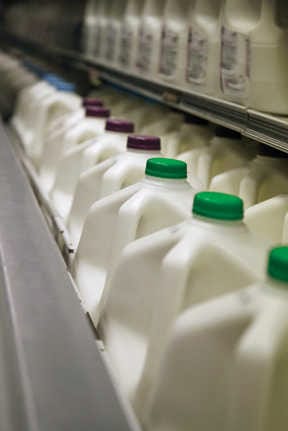Welcome to Fats Friday! In honor of February being American Heart Month, we’ll be spending each Friday sharing fun facts about fats in different foods like dairy, meat and seafood, oils, and nuts. Stay tuned each week to see more great ways to show some love for your heart with food!
 Many of us are familiar with the slogan, “got milk?” But how important is dairy to heart health? It might surprise you.
Many of us are familiar with the slogan, “got milk?” But how important is dairy to heart health? It might surprise you.
While some only think of cow’s milk when it comes to dairy, it’s much more than that. Besides milk, the dairy food group consists of yogurt, cheese, and fortified soymilk. All these foods contain a variety of nutrients known to promote good health. Calcium, potassium, magnesium, protein, vitamin D are just a few that offer great benefits.
ID’ing Dairy
Some items are often mistaken for dairy products. You might find butter, eggs, coconut milk, almond milk, cream, and cream cheese all in the refrigerated dairy section at the grocery store. But, they aren’t actually dairy products!
FUN FACT: Eggs are recommended as part of the Protein Food Group.
Dairy and Heart Health
Calcium: Calcium is a vital nutrient that aids bone health, blood clotting and muscle contraction. Remember, your heart is the most important muscle in your body!
Potassium: Potassium is also good for heart health, specifically when it comes to keeping your blood pressure in check. Americans don’t consume enough potassium. Because of our low consumption, the Dietary Guidelines for Americans consider potassium a “nutrient of concern.” Currently, we only get about 57% (2665 mg) of the daily amount that is recommended (4700 mg). so dairy is one great way to step it up.
DID YOU KNOW: Coffee, milk and white potatoes are leading sources of potassium in the American diet.
Vitamin D: Dairy is also an important source of Vitamin D. Vitamin D has a limited presence in in food sources. That’s why fortification of vitamin D in milks and yogurt is so important. Research continues to uncover new possible benefits of Vitamin D for heart health, such as lowering your risk of diabetes and hypertension.
All in all, “consumption of nutrient-rich dairy foods — such as milk, cheese and yogurt — is linked to a reduced risk of cardiovascular disease and lower blood pressure in adults, as noted in the current Dietary Guidelines for Americans,” says Dr. Greg Miller of the National Dairy Council.
How much dairy should we be eating?
This question comes up a lot. Luckily, nutrition experts have an answer! As with every food, portion control is key. The Dietary Guidelines for Americans recommend you have 3 cups of low-fat or non-fat milk or dairy every day. It doesn’t all have to be milk. Dairy equivalents can be milk (cow, goat or soy), cheese, or yogurt.
DID YOU KNOW: A dairy serving can be 1 cup (8 ounces) of milk, soy milk or yogurt, or between 1.5—2 ounces of cheese.
Dairy Fat Facts
 Dairy is a source of fat in our diet. Unless you’re eating fat-free dairy, there are saturated and unsaturated fats in every serving. All foods that contain fat have more than one type of fat in them. Dairy is no different.
Dairy is a source of fat in our diet. Unless you’re eating fat-free dairy, there are saturated and unsaturated fats in every serving. All foods that contain fat have more than one type of fat in them. Dairy is no different.
Limiting the amount of saturated fat in our diet can help keep our hearts healthy. To reduce the amount of calories that we eat from saturated fat, the Dietary Guidelines encourage us to choose low-fat or non-fat versions of dairy products. By choosing lower fat versions of your favorite dairy foods, you can take an active step in meeting this goal. As a bonus, you’re still getting all the good nutrition that dairy foods have to offer. Our friends at MyPlate have put together this handy list of 10 tips to including more fat-free and low-fat dairy in your diet. Give these tips a try!
FUN FACT: All milk, regardless of fat content, contains the same amounts of vitamin A (10%), vitamin D (25%), calcium (30%) and protein (8 grams). Low-fat or skim milk is a win-win!
Bottom Line
Dairy foods can be an essential part of a healthful diet. Including fat-free and low-fat varieties in your diet is a great step toward improving heart health. Just remember that this doesn’t mean you should avoid fat altogether. Regardless of the food source, it’s the type of fat we eat that has the bigger impact on our health, rather than the amount of fat we eat.
Additional Reources
Fats Friday (January 30): Go Nuts for Heart Health!
Dietary Fats: Balancing Health and Flavor
Blog by Kris Sollid, RD, Director, Nutrients Communications, with contributions from Erica Gavey, UMD Dietetic Intern.

